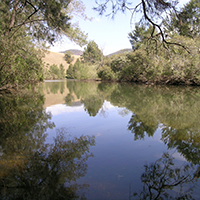Hitting the sweet spot of complexity: Reasons why the development of new custom-tailored models is still warranted and should be encouraged in aquatic sciences

Submitted: 20 May 2021
Accepted: 11 September 2021
Published: 27 September 2021
Accepted: 11 September 2021
Abstract Views: 876
PDF: 256
HTML: 14
HTML: 14
Publisher's note
All claims expressed in this article are solely those of the authors and do not necessarily represent those of their affiliated organizations, or those of the publisher, the editors and the reviewers. Any product that may be evaluated in this article or claim that may be made by its manufacturer is not guaranteed or endorsed by the publisher.
All claims expressed in this article are solely those of the authors and do not necessarily represent those of their affiliated organizations, or those of the publisher, the editors and the reviewers. Any product that may be evaluated in this article or claim that may be made by its manufacturer is not guaranteed or endorsed by the publisher.
Similar Articles
- Marina M. Manca, Nicoletta Riccardi, In memory of Oscar Ravera , Journal of Limnology: Vol. 75 No. s2 (2016): Lake Orta: a new lease on life
- Aldo MARCHETTO, Rosario MOSELLO, Michela ROGORA, Marina MANCA, Angela BOGGERO, Giuseppe MORABITO, Simona MUSAZZI, Gabriele A. TARTARI, Anna M. NOCENTINI, Alessandra PUGNETTI, Roberta BETTINETTI, Pierisa PANZANI, Michele ARMIRAGLIO, Pierluigi CAMMARANO, Andrea LAMI, The chemical and biological response of two remote mountain lakes in the Southern Central Alps (Italy) to twenty years of changing physical and chemical climate , Journal of Limnology: Vol. 63 No. 1 (2004)
- Lluís CAMARERO, Marisol FELIP, Marc VENTURA, Frederic BARTUMEUS, Jordi CATALAN, The relative importance of the planktonic food web in the carbon cycle of an oligotrophic mountain lake in a poorly vegetated catchment (Redó, Pyrenees) , Journal of Limnology: Vol. 58 No. 2 (1999)
- Nicoletta RICCARDI, Monica MANGONI, Considerations on the biochemical composition of some freshwater zooplankton species. , Journal of Limnology: Vol. 58 No. 1 (1999)
- Zhuo Zhang, Changchun Huang, Fei Guo, Zhiyao Song, Di Hu, A new technology for suspended sediment simulation in Lake Taihu, China: Combination of hydrodynamic modeling and remote sensing , Journal of Limnology: Vol. 78 No. 1 (2019)
- Paul LOGAN, Ecological quality assessment of rivers and integrated catchment management in England and Wales , Journal of Limnology: Vol. 60 No. s1 (2001): Scientific and legal aspects of biological monitoring in freshwater
- Gianpaolo SALMOIRAGHI, Bruna GUMIERO, Andrea PASTERIS, Susanna PRATO, Carla BONACINA, Giuliano BONOMI, Breakdown rates and macroinvertebrate colonisation of alder (Alnus glutinosa) leaves in an acid lake (Lake Orta, N Italy), before, during and after a liming intervention , Journal of Limnology: Vol. 60 No. 1 (2001)
- The MOLAR Water Chemistry Group, The MOLAR Project: atmospheric deposition and lake water chemistry , Journal of Limnology: Vol. 58 No. 2 (1999)
- Cristiana CALLIERI, Roberto BERTONI, Organic carbon and microbial food web assemblages in an oligotrophic alpine lake , Journal of Limnology: Vol. 58 No. 2 (1999)
- Qiuqi Lin, Liang Peng, Yang Yang, Bo-Ping Han, Copepods act as omnivores in a (sub)tropical reservoir: Implication for the top-down effect on phytoplankton , Journal of Limnology: Vol. 77 No. 2 (2018)
<< < 61 62 63 64 65 66 67 68 69 70 > >>
You may also start an advanced similarity search for this article.

 https://doi.org/10.4081/jlimnol.2021.2035
https://doi.org/10.4081/jlimnol.2021.2035






